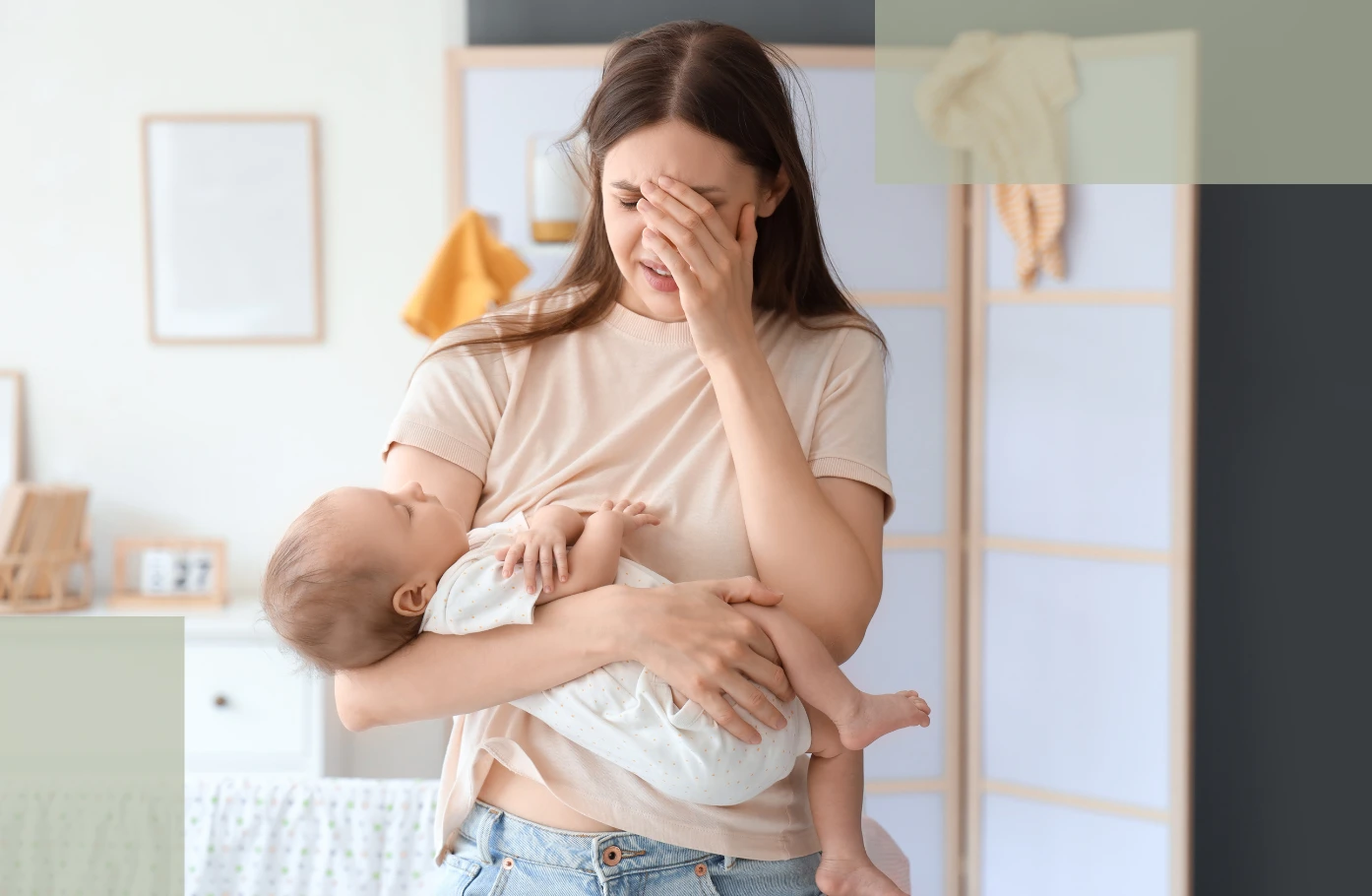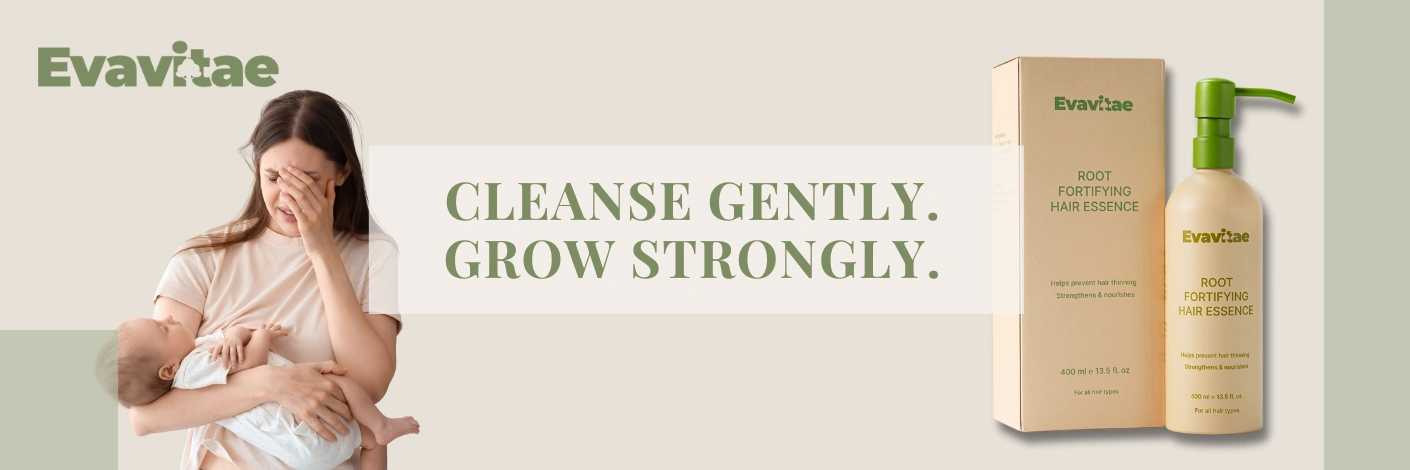
Postpartum hair loss often arrives unexpectedly — just when new mothers begin to feel stable again, they notice handfuls of hair falling out. While this can feel alarming, it’s both common and temporary.
Still, healing goes beyond simply choosing a “best shampoo for postpartum hair loss.” True regrowth begins inside your body, supported by nutrients, hormones, and self-care — and only then does a gentle, restorative shampoo complete the picture.
In this guide, we’ll explore how to nourish your body and scalp simultaneously — rebuilding strength, balance, and confidence from the inside out.
Why Postpartum Hair Loss Happens
During pregnancy, estrogen levels rise, keeping hair in its growth phase longer and giving it extra fullness. After childbirth, estrogen drops sharply, and many follicles enter a resting (telogen) phase. Around two to four months postpartum, shedding becomes visible — a condition known as postpartum telogen effluvium (Cleveland Clinic, 2023).
This phase usually improves within 6–12 months as hormones normalize. However, when compounded by stress, lack of sleep, or nutritional deficiencies, the recovery can slow down significantly. In these cases, a dual approach — nutritional repair and topical care — is essential.
It’s also helpful to understand that recovery isn’t identical for everyone — this overview of postpartum hair loss in men vs women explains how hormonal balance and scalp recovery can differ between genders.
Hormonal changes during pregnancy can also temporarily alter the hair growth cycle. To understand how to protect your scalp through these shifts, visit our article on hair loss during pregnancy and gentle scalp care for expecting mothers.
Nourishing Hair from Within: Key Vitamins and Minerals
Iron + Vitamin C
Iron deficiency is among the most well-documented causes of hair loss, especially for women who’ve experienced heavy postpartum bleeding. Iron supports follicle cell division and oxygen delivery to the scalp, while Vitamin C enhances iron absorption and aids collagen synthesis.
→ Harvard Health: “Vitamins, minerals, and hair loss — is there a connection?”
Vitamin D
Low Vitamin D levels are often found in individuals experiencing excessive shedding. This vitamin helps regulate the hair cycle and may stimulate new follicle activity, though evidence is still emerging.
→ PMC Review: “The Role of Vitamins and Minerals in Hair Loss”
Biotin and B-Complex Vitamins
Biotin is frequently promoted as a “hair vitamin,” but studies suggest it’s beneficial primarily when deficiency exists. B-vitamins, such as B6, B12, and folate, support energy metabolism, stress resilience, and cell renewal — all vital in the postpartum phase.
Zinc, Selenium, and Protein
Zinc assists with follicle repair, while selenium helps neutralize oxidative stress. Yet both must be consumed in balance — over-supplementation can worsen shedding. Protein, meanwhile, provides the amino acids required to build keratin, the structural foundation of hair.
Once you’ve supported recovery from the inside, it can also help to focus on gentle, natural ways to feel confident again after postpartum shedding—including how to choose a shampoo routine you’ll actually stick with.
Rebuilding the Outside: Choosing a Gentle Shampoo
Even with perfect nutrition, external care matters. Hormonal fluctuations can make the scalp more sensitive, dry, or inflamed, which means aggressive cleansers or strong fragrances may trigger irritation or further hair loss.
When evaluating the best shampoo for postpartum hair loss, look for:
- Mild, sulfate-free surfactants (e.g., sodium cocoyl isethionate, coco-glucoside)
- Botanical oils like jojoba, avocado, or argan oil for moisture without residue
- Nourishing actives such as niacinamide, peptides, and panthenol
- No silicones, parabens, or synthetic dyes
- Dermatologically tested and breastfeeding-safe formulas
A scientifically formulated gentle cleanser such as the
helps rebalance the scalp, enhance circulation, and prepare follicles for healthy regrowth.
The Inside–Outside Synergy
Healthy hair growth is not the result of a single product — it’s the outcome of consistent synergy between inner nourishment and topical care.
Focus Area | Internal Support | External Support |
Months 1–3 | Bloodwork (iron, vitamin D, thyroid); diet rich in protein, leafy greens, and whole grains | Use a gentle volumizing shampoo every 1–2 days; massage scalp for 3–5 minutes |
Months 4–8 | Continue balanced nutrition; consider targeted supplements if deficient | Add lightweight serums and masks; avoid harsh dyes or heat tools |
Months 9–12 | Maintain healthy habits; monitor progress | Gradually reduce shedding; maintain with scalp-friendly products |
Consistency is key. Because the hair cycle is slow, most women see noticeable regrowth between 8–12 weeks — and fuller density around six months.
How Stress and Hormones Interact
Beyond nutrients, stress plays a major role in postpartum hair loss. Cortisol, the stress hormone, can disrupt normal hair cycling. Combine this with fluctuating estrogen and progesterone, and it’s no wonder many mothers experience thinning. For a deeper look at this link, see our article on stress-related hair loss and practical steps to take action.
Simple relaxation techniques — such as mindfulness, gentle exercise, or scalp massage — can make a measurable difference. Supporting your endocrine balance through rest, hydration, and nourishing meals accelerates recovery far more effectively than any single topical product.
💡 Curious about causes and recovery paths for hair loss? Read more in our Hair Loss 101 Hub.
Your 360° Recovery Routine
- Rebuild Nutrient Foundations – Correct iron, vitamin D, and protein deficiencies under medical guidance.
- Adopt a Gentle Cleansing Habit – Use sulfate-free, fragrance-free shampoos designed for postpartum recovery.
- Massage the Scalp Regularly – Improves circulation and promotes follicle stimulation.
- Reduce Stress Load – Prioritize sleep and self-care; mindfulness lowers cortisol impact.
- Track Progress – Take monthly photos and adjust care routines accordingly.
Over time, your scalp’s microbiome stabilizes, new baby hairs appear along the hairline, and confidence gradually returns.
Why “Rebuilding from the Inside Out” Matters
Many mothers focus exclusively on topical products, but without sufficient nutrients, follicles can’t fully recover. Conversely, even the most balanced diet benefits from external support to maintain a clean, hydrated, and oxygenated scalp environment.
Combining both approaches — gentle shampoo + nutritional repletion — gives your body what it truly needs: balance, patience, and steady renewal.
Conclusion: Restore Strength, Balance, and Confidence
Postpartum hair loss is temporary, but your approach determines how quickly recovery happens. The best shampoo for postpartum hair loss doesn’t just cleanse — it works in harmony with your body’s inner rebuilding process.
Choose kindness for yourself, gentleness for your scalp, and nourishment for your body. Over time, you’ll not only see stronger strands — you’ll feel the quiet confidence of healing from within.
Explore gentle recovery steps and dermatologist insights in the Complete Postpartum Hair Regrowth Hub.
Evavitae products are now available exclusively at www.evavitae.com.




Add comment
You must be logged in to post a comment.